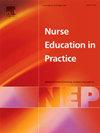Comparative analysis of work-related factors associated with burnout and its dimensions among nursing faculty in Canada and the United States
IF 3.3
3区 医学
Q1 NURSING
引用次数: 0
Abstract
Objective
This study aimed to investigate and compare burnout and its dimensions—exhaustion, cynicism and professional efficacy—across workplace and socio-demographic characteristics among nursing faculty in Canada and the United States (U.S.).
Background
Burnout among nursing faculty affects the availability and retention of educators, crucial for producing qualified nurses to meet healthcare demands. Despite its significance, research in this area remains limited.
Design
A correlational cross-sectional survey was used.
Methods
An online survey was administered to 640 nursing faculty in Canada and 111 in the U.S. Burnout was measured using the Maslach Burnout Inventory and multivariate linear regression identified predictors of burnout.
Results
Overall, 62.4 % of participants reported moderate to high burnout. Canadian faculty were primarily involved in undergraduate and graduate education, whereas U.S. faculty devoted more time to service activities. Predictors of burnout and its dimensions varied by country. In Canada, older faculty (≥60 years) and those with a nursing diploma reported lower burnout, while those with a Doctor of Nursing Practice reported higher levels. In the U.S., burnout was higher among younger faculty (≤39 years), those with more teaching hours and lower among non-tenured faculty.
Conclusion
Factors influencing burnout differ between Canada and the U.S., reflecting variations in academic environments. Tailored interventions, such as workload balancing and targeted support, are essential for addressing burnout and improving faculty retention.
加拿大和美国护理专业教师职业倦怠相关工作因素及其维度的比较分析
本文章由计算机程序翻译,如有差异,请以英文原文为准。
求助全文
约1分钟内获得全文
求助全文
来源期刊

Nurse Education in Practice
NURSING-
CiteScore
5.40
自引率
9.40%
发文量
180
审稿时长
51 days
期刊介绍:
Nurse Education in Practice enables lecturers and practitioners to both share and disseminate evidence that demonstrates the actual practice of education as it is experienced in the realities of their respective work environments. It is supportive of new authors and will be at the forefront in publishing individual and collaborative papers that demonstrate the link between education and practice.
 求助内容:
求助内容: 应助结果提醒方式:
应助结果提醒方式:


